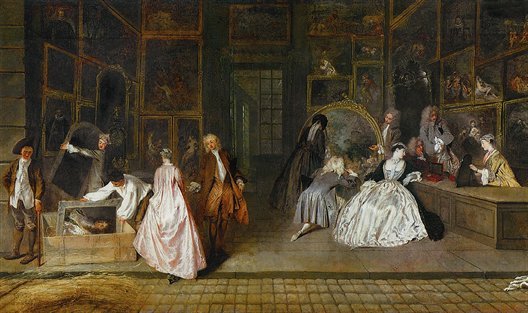Antoine Watteau,
Gersaint’s Signboard, 1720.
Oil on canvas, 163 x 306 cm.
Schloss Charlottenburg, Berlin.
Hubert Robert (1733-1808) studied all the usual disciplines before deciding, when he was 21, to become a painter. He went to Rome for eleven years and there busied himself so intensively with the painting of landscapes over old ruins that he came to be regarded as one of the champions of landscape painting in the 19th century. From this period came the Antique Ruins (1754-1765), an Imaginary View of the Cestuis-Pyramid (1760-1770) and, much later, the Classical Ruins (1798). When he returned to Paris he painted the Demolition of the Houses on the Pont au Change (1788). Five years later he found himself back in prison during the Revolution. As a result of the fall of Maximilien Robespierre (1758-1794), he was free again to join the Jacobins. Robert immediately painted the Louvre Art Gallery several times, as in the View of the Gallery in Ruins (1796), the Design for the Grande Galerie in the Louvre and also, when it was finished, the Gallery of the Louvre (1801-1805).
Charles-Andre van Loo (1705-1765) was a Rococo painter who is no longer very well-known. He was born in Nice into a Dutch artist family famous in the 17th and 18th centuries. He painted mythological scenes and allegories but also genre pictures. For instance, he created The Concert before the Sultan and Sultana and Slave Girl, both from 1747.
